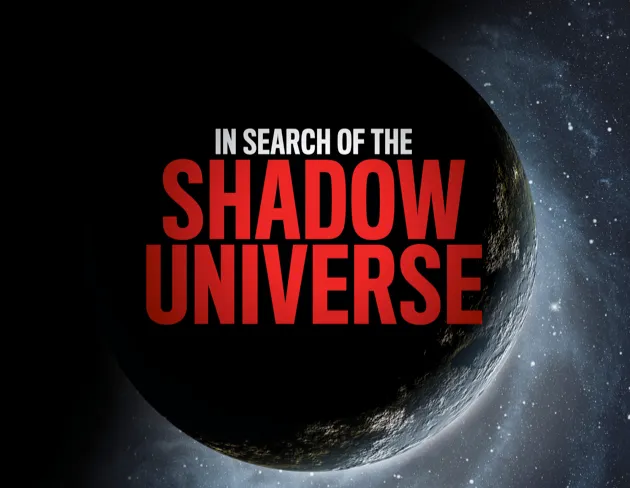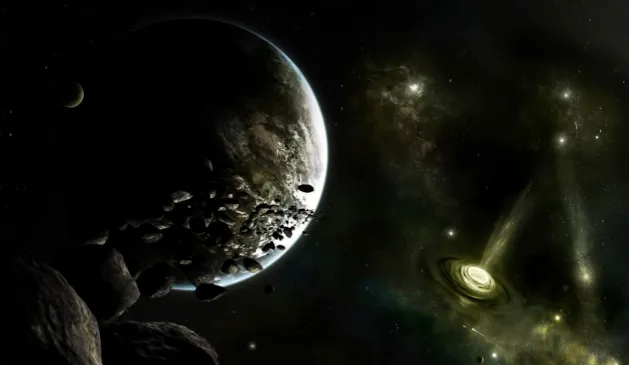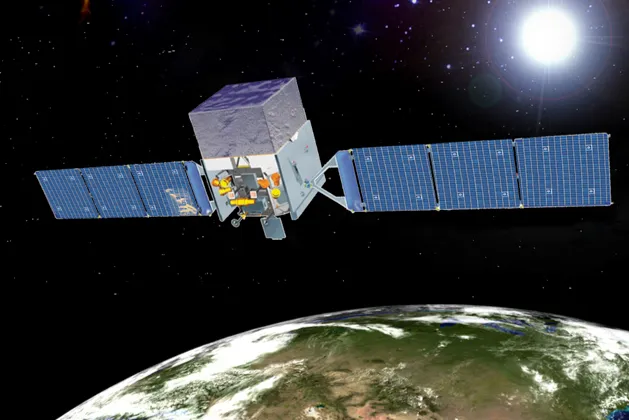The American astronomer Carl Sagan once said the reason he preferred science to science fiction was that science is stranger. Well, try this scientific claim on for size: there is a second galaxy occupying pretty much the same space as our Milky Way. Unnoticed because it is invisible to our telescopes, it may even possess invisible stars, invisible planets and invisible life.

Could a hidden world of dark matter exist right under our noses?
The idea of a shadow Milky Way may sound crazy, but it is a serious suggestion from physicists in the US trying to make sense of our Universe’s invisible, or ‘dark’, matter. “We think it’s worth exploring because it might explain some puzzling observations and it is testable,” says Matthew McCullough, from the Center for Theoretical Physics at Massachusetts Institute of Technology near Boston.
Dark matter has been postulated to explain several baffling astronomical observations. One is that stars in the outer regions of spiral galaxies like our own are orbiting too fast. Like children on a speeded-up roundabout, they should be flung off into interstellar space. They are not, astronomers reason, thanks to the gravitational grip of a huge amount of matter which gives out no detectable light.
A second observation which dark matter is used to explain is the fact that you are reading these words. Observations of the cosmic background radiation, the ‘afterglow’ of the Big Bang fireball, show that matter in the beginning was spread very evenly throughout space. There were, however, places where it was slightly denser than average. These regions, having stronger gravity than their surroundings, dragged in matter faster and became ever denser. But this process is too slow to build a galaxy as big as the Milky Way in the 13.8-billion-year age of the Universe. To explain our existence it is necessary to postulate a large amount of dark matter whose extra gravity greatly speeded up galaxy formation.
Dark matter theories
Dark matter accounts for 26.8 per cent of the mass-energy of the Universe. It outweighs the normal stuff – the 4.9 per cent atomic matter that makes up you, me and everything else – five times over. The question is: what is it? There have been scores of suggestions, from fridge-sized black holes left over from the Big Bang to relics from the future whose ‘arrow of time’ runs backwards. But the most popular idea is that dark matter is made of a hitherto undiscovered subatomic particle.
There are many candidates – for example axions, which might fix a problem with nature’s ‘strong’ force, and weakly interacting massive particles. WIMPs are predicted by theories such as supersymmetry (SUSY), which attempts to show that one set of nature’s fundamental particles – fermions – are simply the flip-side of its other set, bosons. The particles come in the guise of a whole set of ‘superpartners’ of the known subatomic particles. The lightest stable superpartner, the neutralino, is a popular candidate for the dark matter.
But there is a problem. No neutralino or any other dark matter particle has yet been conjured up by the super-high-energy collisions at the Large Hadron Collider near Geneva. “It’s possible one will turn up when the accelerator is restarted at an even higher collision energy in 2015,” says McCullough. “But what if it does not?”
This has got some physicists wondering whether our model of dark matter needs to be tweaked. “The everyday world is complex – built not out of a single Lego brick particle but a whole multitude of them,” says McCullough. “What if the dark matter is like that as well?”

Is it time for a new theory of dark matter?
McCullough has been working with Lisa Randall of Harvard University, author ofWarped Passagesand the first tenured female theoretical physicist at both Harvard and MIT. She and her colleagues have proposed a new form of matter that would interact with itself while shunning normal matter. Consequently, we would not know that it is there.
Most importantly, such self-interacting dark stuff would behave very differently from conventional dark matter. Our Milky Way is believed to have formed from a giant spherical, rotating cloud of dark matter intermingled with a little normal matter. The normal stuff began to shrink under gravity. This happened faster between the poles than around the equator, where the outward ‘centrifugal force’ opposed gravity. The end result was a thin, flattened disc which then fragmented into stars. This was only possible because the normal matter was able to shed its heat – heat that was pushing outwards and preventing gravity shrinking the cloud – by emitting that heat energy as electromagnetic waves, or light. Crucially, however, the dark matter could not give out light. Unable to lose energy and shrink into a disc, it remained in a spherical cloud. This has led to a picture of our Galaxy as a flattened spiral disc of stars embedded in a spherical cloud of dark matter.
But Randall and her colleagues say the kind of dark matter they envisage might interact with itself via a force analogous to our electromagnetic force. So it might be able to lose energy by giving out dark electromagnetic waves, or ‘dark light’. “The dark matter could then collapse into a thin disc just like normal matter,” she says. “We call it double disc dark matter.”
Randall is not talking about all the dark matter. A spherical cloud clearly explains the speed of the stars orbiting in our Galaxy, so the lion’s share of the dark matter must still be in this form. But some of the dark matter – comparable in mass perhaps to the visible disc of stars – could be in a flattened disc.
The idea of a double disc might explain some observational anomalies. For instance, NASA’s Fermi Gamma-Ray Space Telescope has detected gamma rays of energy 130 gigaelectronvolts (GeV) coming from the centre of our Galaxy. This could be explained if there exists a dark matter particle of mass 130 GeV – about 130 times the mass of the proton. The gamma rays might then come from the annihilation of such dark matter particles and their antiparticles.

The picture of dark matter spread thinly in a spherical ‘halo’ doesn’t yield a high enough density of such particles to explain such a gamma-ray feature. But “with a double disc, the new component of dark matter could be denser and so find other particles to annihilate with more often,” says Randall.
Detecting dark matter
Currently, many experiments are attempting to detect dark matter particles flying through the Earth. Since dark matter does not interact with normal matter, they use a range of atomic nuclei – from silicon to xenon, fluorine to iodine – and hope to ‘see’ a nucleus recoil when suddenly struck by a dark matter particle.
Most experiments have seen nothing, even though the Sun is orbiting the centre of the Galaxy at 220km/s relative to the dark matter halo. “If some of the dark matter is in a second disc which is turning with the visible galaxy, this is what we would expect,” says McCullough. “The relative motion between the dark and normal discs will be zero, so dark matter will hit the detectors too softly to be noticed.”

However, there is one result that could remove the need for a double disc scenario. While the LUX – Large Underground Xenon – experiment in an old gold mine in South Dakota has seen nothing, the CDMS – Cryogenic Dark Matter Search – experiment in the Soudan mine in Minnesota has seen three events, all close in energy between 8 and 12 kiloelectronvolts.
How can this be? McCullough and Randall claim the circle can be squared with another twist to the story. Imagine a dark matter particle lodged in a high-energy state. When it collides with a silicon nucleus in CDMS, it loses energy, causing the nucleus to recoil. However, the energy liberated in such collisions is simply not enough to generate a signal in the LUX experiment.

Critics might say that dark matter does not explain what we see, and that Randall and her colleagues are simply adding bells and whistles. They might say it is reminiscent of the Greeks, who on discovering their theory that planets orbit in circles did not fit the data, added circles within circles, or ‘epicycles’, until it did.
“I think it’s even worse than adding epicycles,” says Mordehai Milgrom of the Weizmann Institute in Rehovot, Israel. “It’s adding epicycles just for the heck of it.” Milgrom is the originator of the idea of Modified Newtonian Dynamics, or MOND, which contends that the anomalous orbital motion of stars in spiral galaxies is explained not by the gravity of a vast amount of invisible dark matter, but by the fact that gravity is stronger than Newton would have predicted.
Randall shrugs off such criticism. “We are taking one step further to see whether dark matter might have a richer structure, just like ordinary matter does,” she says. “We are making a reasonable assumption that some of it interacts.”
McCullough concedes that the double disc dark matter idea does not satisfy the old addage of Occam’s razor, which says that if there are two competing theories, the simplest is usually true. “But what if dark matter truly is complex?” he says. “We have no choice but to take what nature gives us.”
So how could we find evidence of our Milky Way’s second disc? “It will influence the gravitational field experienced by stars in the solar neighbourhood,” says Randall. “Precision observations of their motion might therefore reveal the disc.”
The second disc might not have the same thickness or extent as ours. “But even if they didn’t start out aligned,” says Randall, “the gravitational tug between the dark disc and the normal disc would long ago have aligned them.”
The existence of a dark electromagnetic force would enable a subcomponent of dark matter to settle into a shadow disc. That disc might then fragment into star-sized clumps thanks to dark equivalents of the known forces. “Whether dark stars might ignite in these clumps would depend on the existence of dark strong and weak nuclear forces to ignite nuclear reactions,” says Randall.
Dwellers in the dark?
It’s fun to speculate that a shadow universe of dark matter might not be merely as complex as the Universe we can see, but more complex. Maybe there are six fundamental forces rather than four. Could that explain why we’ve seen no sign of extraterrestrials despite searching for signals for over half a century? Could it be that the dark matter Universe is simply far more interesting? Is it possible that if you’re an advanced extraterrestrial civilisation, the shadow Universe is where you have to be because that is where all the action is? “Now that really is in the realms of science fiction!” laughs McCullough.
Marcus Chown is a former radio astronomer, and author of several books includingWhat a Wonderful World.This article first appeared in the February 2014 issue ofFocus.
Follow Science Focus onTwitter,Facebook, Instagramand Flipboard